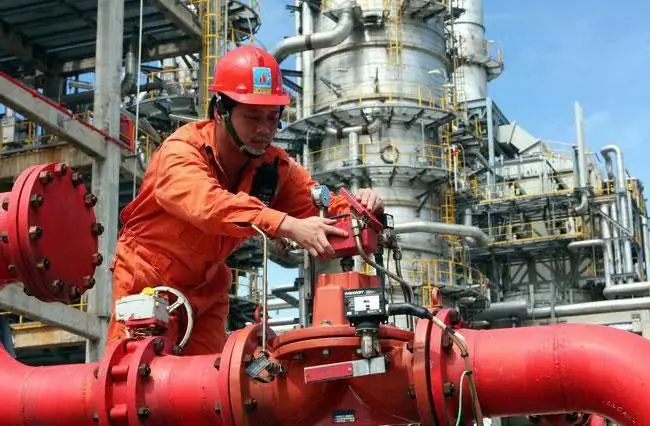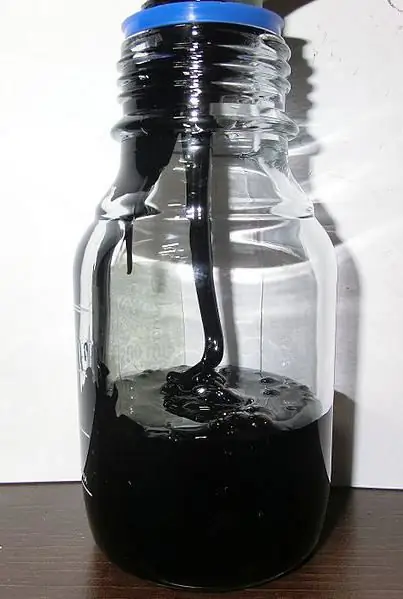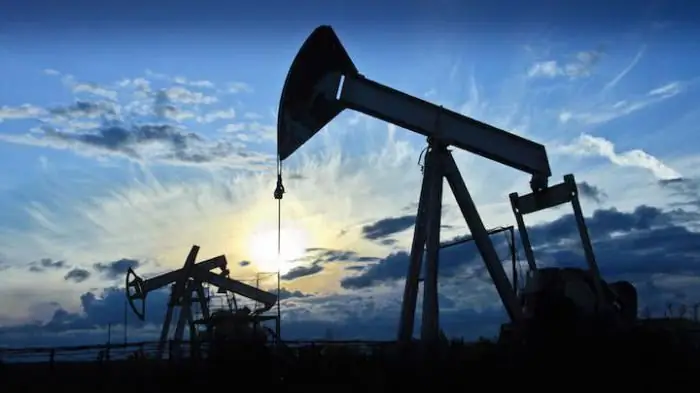2025 Author: Howard Calhoun | [email protected]. Last modified: 2025-01-24 13:10:47
Oil is a flammable oily liquid, ranging in color from light brown (almost transparent) to dark brown (almost black). The density is divided into light, medium and heavy.
Currently, it is impossible to imagine the modern world without oil. It is the main source of fuel for various transport, raw materials for the production of various consumer goods, medicines and other things. How is oil produced?
Developments

Oil along with natural gas accumulates in porous rocks called reservoirs. They may be different. A good reservoir is considered to be a sandstone layer, which is located between layers of clay and shale. This eliminates the leakage of oil and gas from underground reservoirs.
Once minerals are discovered, their in situ reserves and quality are assessed, and a method is developed for safely extracting and transporting them to a processing facility. If, according to calculations, oil and gas production in this field is economically profitable, then the installation of an operationalequipment.
Features of oil production

In natural reservoirs where oil is extracted, it is in its raw state. As a rule, combustible liquid is mixed with gas and water. Often they are under high pressure, under the influence of which oil is displaced to unequipped wells. This can lead to problems. Sometimes the pressure is so low that a special pump is required.
The oil production process can be divided into three stages:
- The movement of fluid along the reservoir towards the well. It is carried out due to natural or artificially created pressure difference.
- The movement of fluid through the well - from the bottom to the mouth.
- Collection of oil with gas and water on the surface, their separation, cleaning. And then the liquid is transported to processing plants.
There are various methods of oil production, which depend on the type of mineral deposit (land, seabed), type of reservoir, depth of occurrence. Also, the method may change as the natural reservoir empties. It is worth noting that offshore oil production is a more complex process, as it requires subsea installations.

Natural mining
How is oil produced? To do this, use the force of pressure, natural or artificially created. The operation of a well at reservoir energy is called flowing. In this case, under the pressure of groundwater, gas, oil rises to the top, without requiring the involvement ofadditional equipment. However, the flowing method is used only for the primary extraction of a mineral, when the pressure is significant and is able to lift the liquid up. In the future, it is necessary to use additional equipment to fully pump out the oil.
The fountain method is the most economical. To regulate the oil supply, special fittings are installed that seal the wellhead and control the volume of the supplied substance.

After primary production, secondary and tertiary methods are used to maximize the use of the deposit.
Primary, secondary and tertiary methods
In the natural way of oil production, a phased method is used:
- Primary. The liquid enters under the influence of high pressure in the reservoir, which is formed from groundwater, gas expansion, and so on. With this method, the oil recovery factor (ORF) is approximately 5-15%.
- Secondary. This method is used when natural pressure is no longer enough to lift oil through the well. In this case, a secondary method is used, which consists in supplying energy from the outside. In this capacity, the injected water, associated or natural gas acts. Depending on the rocks of the reservoir and the characteristics of the oil, the recovery factor for the secondary method reaches 30%, and the total value is 35-45%.
- Tertiary. This method is to increase the mobility of oil to increase its return. One way is TEOR, withwhich, due to the heating of the fluid in the reservoir, reduces the viscosity. For this, steam is most often used. Less commonly used is partial burning of oil in situ, directly in the formation itself. However, this method is not very efficient. To change the surface tension between oil and water, special surfactants (or detergents) can be introduced. The tertiary method allows to increase the oil recovery factor by about 5-15%. This method is used only if oil production continues to be profitable. Therefore, the application of the tertiary method depends on the price of oil and the cost of its extraction.
Mechanized method: gas lift

If the energy to lift the oil is supplied from outside, then this method of extraction is called mechanized. It is divided into two types: compressor and pump. Each of the methods has its own characteristics.
Compressor is also called gas lift. This method involves pumping gas into a well where it mixes with oil. As a result, the density of the mixture decreases. The bottomhole pressure also decreases and becomes lower than the reservoir pressure. All this leads to the movement of oil to the surface of the earth. Sometimes pressurized gas is supplied from adjacent formations. This method is called "compressorless gas lift".
In older fields, an airlift system is also used, in which air is used. However, this method requires the combustion of petroleum gas, and the pipeline has low resistance to corrosion.
Gas lift for oil production is used inWestern Siberia, Western Kazakhstan, Turkmenistan.
Mechanized method: use of pumps

When pumping, pumps are lowered to a certain depth. The equipment is divided into different types. Rod pumps are the most widely used.
Let's consider how oil is produced in this way. The principle of operation of such equipment is as follows. Pipes are lowered into the well, inside of which a suction valve and a cylinder are located. The latter has a plunger with a pressure valve. The movement of oil is carried out due to the reciprocating movement of the plunger. At the same time, the suction and discharge valves open and close alternately.
Productivity of rod pumps is approximately 500 cu. m / day at a well depth of 200-400 m, and at a depth of 3200 m - up to 20 cubic meters. m/day.
Standless sediments can also be used for oil production. In this case, electrical energy is supplied to the equipment through the wellbore. For this, a special cable is used. Another type of energy-carrying flow (heat carrier, compressed gas) can also be used.
In Russia, a centrifugal type of electric pump is more often used. With the help of such equipment, most of the oil is extracted. When using electric pumps on the ground, it is necessary to install a control station and a transformer.
Production in the countries of the world

It was considered how oil is extracted from natural reservoirs. Costsget acquainted with the pace of development. Initially, until the mid-1970s, oil production doubled almost every decade. Then the pace of development became less active. The volume of oil that was pumped from the beginning of production (from the 1850s) until 1973 amounted to 41 billion tons, almost half of which fell on 1965-1973.
The world's largest oil producers today are such countries as Saudi Arabia, Russia, Iran, USA, China, Mexico, Canada, Venezuela, Kazakhstan. It is these states that are the main ones in the “black gold” market. It should be noted that oil production in the United States is not in the top positions, but the country bought large deposits in other states.
The largest oil and gas basins in which oil and gas is produced are the Persian Gulf, the Gulf of Mexico, the South Caspian, Western Siberia, the Algerian Sahara and others.
Oil reserves
Oil is a non-renewable resource. The volume of known deposits is 1200 billion barrels, and unexplored - approximately 52-260 billion barrels. Total oil reserves, taking into account its current consumption, will be enough for about 100 years. Despite this, Russia plans to increase the production of "black gold".
The countries with the largest oil production are as follows:
- Venezuela.
- Saudi Arabia.
- Iran.
- Iraq.
- Kuwait.
- UAE.
- Russia.
- Libya.
- Kazakhstan.
- Nigeria.
- Canada.
- USA.
- Qatar.
- China.
- Brazil.
Oil in Russia
Russia is one of the leading oil producing countries. It is not only widely used in the country itself, a significant part is exported to various states. Where is oil produced in Russia? The largest deposits today are in the Khanty-Mansiysk Autonomous Okrug, the Yamalo-Nenets Autonomous Okrug and the Republic of Tatarstan. These regions account for more than 60% of the total volume of produced fluid. Also, the Irkutsk region and the Republic of Yakutia are places where oil is produced in Russia, showing excellent results in increasing volumes. This is due to the development of a new export direction Siberia - the Pacific Ocean.
Oil prices
The price of oil is formed from the ratio of supply and demand. However, in this case there are some peculiarities. Demand remains virtually unchanged and has little effect on price dynamics. Of course, it grows every year. But the main factor in pricing is supply. A slight decrease in it leads to a sharp jump in value.
With the increase in the number of cars and similar equipment, the demand for oil is increasing. But the deposits are gradually drying up. All this, according to experts, will eventually lead to an oil crisis, when demand far exceeds supply. And then prices will skyrocket.
It is also worth noting that the price of oil is one of the most important political instruments in the global economy. Today it is about $107 per barrel.
Recommended:
Price lists - what is it? Price list form

Price lists are systematized collections of tariffs (prices) by types and groups of services and goods. In other words, it is a price guide for certain goods. Prices that are fixed in such directories are called list price
What is produced from oil? Oil refining technology

What is produced from oil: features, composition, types of products, photos. Oil refining technology: methods
Oil is a mineral. Oil deposits. Oil production

Oil is one of the world's most important minerals (hydrocarbon fuel). It is a raw material for the production of fuels, lubricants and other materials
"Fix Price" - reviews. Fix Price - a chain of stores. Addresses of "Fix Price" stores

Often in an endless stream of cases, we do not have time to buy what we have long wanted, because we simply do not have enough time. After all, in order to go around all the specialized stores in search of a suitable thing, you need to allocate from your fully loaded day the hours you need to buy, and sometimes plan a whole day for this. Such inconvenience completely disappears when "Fix Price" appears in your life, the reviews of which speak for themselves
Why does the ruble depend on oil and not on gas or gold? Why does the ruble exchange rate depend on the price of oil, but the dollar exchange rate does not?

Many in our country are wondering why the ruble depends on oil. Why is it that if the price of black gold decreases, the price of imported goods rises, is it more difficult to get out to rest abroad? At the same time, the national currency becomes less valuable, and with it, all savings

